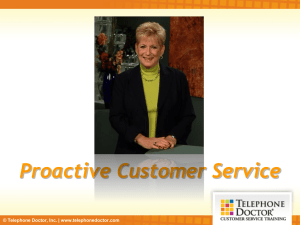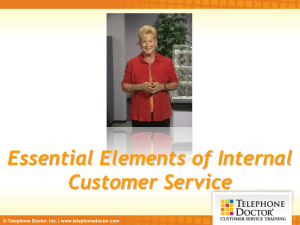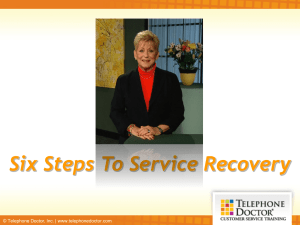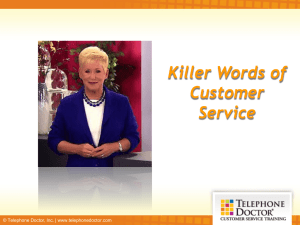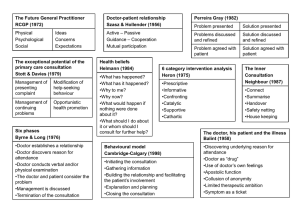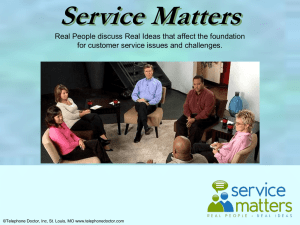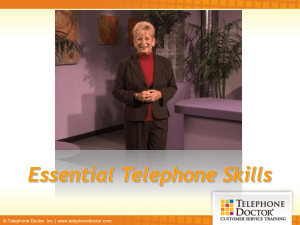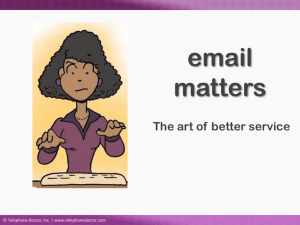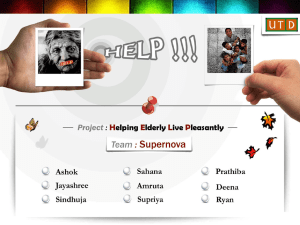TD3FromCurtToCourteous
advertisement
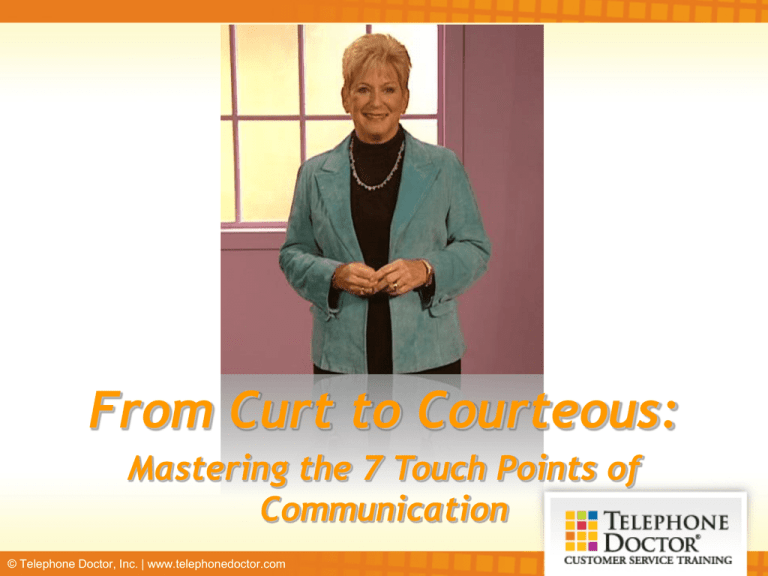
From Curt to Courteous: Mastering the 7 Touch Points of Communication © Telephone Doctor, Inc. | www.telephonedoctor.com You will learn: The appropriate use of the 7 Touch Points of Communication. Gain knowledge and insight into how various forms of communication influence all aspects of life. How to apply correct techniques to various workplace and personal situations. © Telephone Doctor, Inc. | www.telephonedoctor.com Take the Before-andAfter Skills Inventory © Telephone Doctor, Inc. | www.telephonedoctor.com View Program © Telephone Doctor, Inc. | www.telephonedoctor.com Key Point #1: Understanding and Being Understood © Telephone Doctor, Inc. | www.telephonedoctor.com Discuss What is the opposite of understanding and being understood? What are the 7 Touch Points of Communication used today? How will this program help you to avoid being curt and practice being courteous? What is synchronous communication? What is asynchronous communication? Is asynchronous or synchronous a more effective method of communication with customers? What characteristics do the 7 Touch Points have in common with each other? © Telephone Doctor, Inc. | www.telephonedoctor.com Telephone Doctor® Prescription The opposite of understanding and being understood is being misunderstood. Ways to communicate with customers include: letters, telephone, face-to-face, fax, voice mail, email and instant messaging. Synchronous communication is an immediate two-way back and forth exchange of information in real time. Asynchronous communication is one-way communication. Both parties expect the reply to be delayed for a period of time. Both are considered effective in communicating with customers as long as both parties accept the lack of real time and/or the immediate back and forth interaction we receive with sychronous communication. © Telephone Doctor, Inc. | www.telephonedoctor.com Key Point #2: Your Communication Tools © Telephone Doctor, Inc. | www.telephonedoctor.com Discuss When is it best to use asynchronous (or one-way) messages? Which forms of communication rely on the spoken word? Although most methods cross-apply to other touch points, which is the method the majority of customer communications rely on? What are your communication tools while you’re on the telephone with a customer? What are the three keys when you use your voice? What are other factors to take into consideration? © Telephone Doctor, Inc. | www.telephonedoctor.com Telephone Doctor® Prescription Asynchronous or one-way messages are used when customers do not need immediate, time sensitive replies. Communication that relies on the spoken word includes face-to-face, telephone and voice mail. The telephone is currently the way the majority of customer communication takes place. Communication tools, while on the phone: include voice, tone of voice, words used and the listener’s perception. Keys for using your voice effectively are rate of speed, enunciation (speaking clearly) and volume. © Telephone Doctor, Inc. | www.telephonedoctor.com Key Point #3: Effective Voice Mail © Telephone Doctor, Inc. | www.telephonedoctor.com Discuss What has become another important way to leave an asynchronous message in business? What are the keys to a successful business voice mail? What is important in a voice mail message to someone you don’t know well? © Telephone Doctor, Inc. | www.telephonedoctor.com Telephone Doctor® Prescription Voice mail is an important tool in business. Keep voice mails brief, friendly and when possible, add a little humor. To a new customer, introduce yourself, give your company’s name, be brief and include return contact information. And, yes, SMILE! In any voice mail, leave the reason for your call, your name and return number (twice and slowly!) and if there is time, tell your city and time zone. © Telephone Doctor, Inc. | www.telephonedoctor.com Key Point #4: Face-to-Face Communication © Telephone Doctor, Inc. | www.telephonedoctor.com Discuss What are the two elements of face-to-face communication? Why are facial expressions usually considered obvious? In a face-to-face meeting, what can your expression do? Why is it important for your face to reflect your verbal message? How does your body language show your inner feelings? © Telephone Doctor, Inc. | www.telephonedoctor.com Telephone Doctor® Prescription Facial expressions and body language are important keys to effective face-to-face communication. Without using words, your facial expressions can express a wide range of emotion from happy to puzzled to unhappy or angry. The expression on your face can support or nullify your words. Body language is a strong indicator of your interest in the topic at hand. © Telephone Doctor, Inc. | www.telephonedoctor.com Key Point #5: Communication by Written Word © Telephone Doctor, Inc. | www.telephonedoctor.com Discuss When you provide written communication, what does the reader do? What is written word used for? What tools are needed to influence a reader to have a positive interpretation of our meaning? How can you make a message more “reader friendly”? What are the keys to a good message? © Telephone Doctor, Inc. | www.telephonedoctor.com Telephone Doctor® Prescription Remember, when you write something, your reader is interpreting your mood and meaning. The written word is used in letter, email, fax, and instant messaging. Some of the tools needed to influence a reader to have a positive interpretation of your meaning include, making your message “reader friendly” and checking your message to avoid misinterpretation. Keys to a good message: use a brief greeting as a welcome signal and end your message (when necessary) with “thanks”. Being obviously friendly will go a long way towards lessening resentment, disputes and misunderstandings. Always use spell check before sending any written communication. © Telephone Doctor, Inc. | www.telephonedoctor.com Take the Before-andAfter Skills Inventory ANSWERS 01. B 02. T 03. C 04. B 05. T 06. A 07. F 08. E 09. B 10. T © Telephone Doctor, Inc. | www.telephonedoctor.com A CALL TO ACTION! Memorize the following key points. Keep them in mind every time you use the telephone. Practice! © Telephone Doctor, Inc. | www.telephonedoctor.com SUMMARY OF KEY POINTS UNDERSTANDING AND BEING UNDERSTOOD: Ways to communicate with customers: letters, telephone, face-to-face, fax, voice mail, email and instant messaging. Synchronous is two-way communication; Asynchronous is one-way communication. YOUR COMMUNICATION TOOLS: While on the phone, include voice, tone of voice, words used and the listener’s perception. EFFECTIVE VOICE MAIL: Keep brief and friendly; leave reason for call, your name, and return number (twice and slowly), city and time zone, and SMILE! FACE-TO-FACE COMMUNICATION: Facial expression and body language can support or nullify your words. COMMUNICATING WITH THE WRITTEN WORD: The reader is interpreting your mood and meaning; be obviously friendly and spell check. © Telephone Doctor, Inc. | www.telephonedoctor.com From Curt to Courteous: Mastering the 7 Touch Points of Communication © Telephone Doctor, Inc. | www.telephonedoctor.com

